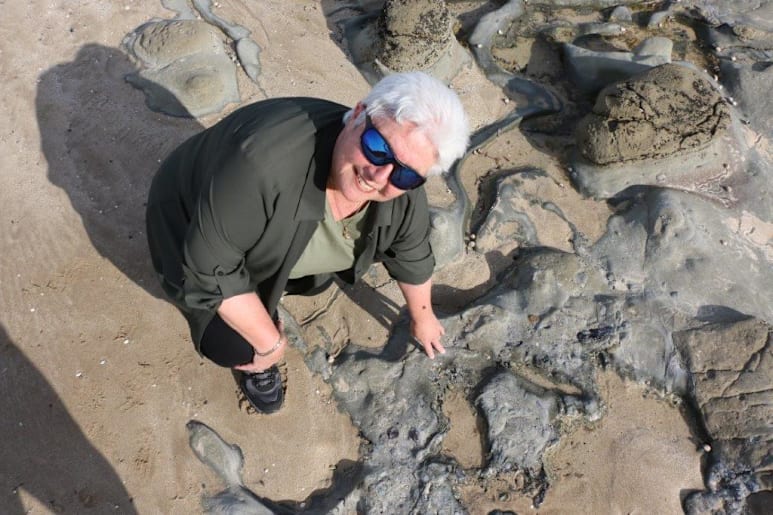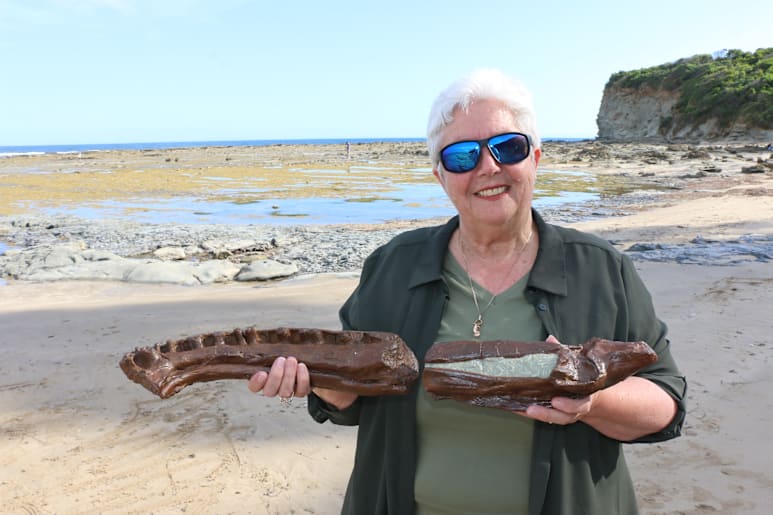Back in 1983, when Dr Tom Rich, the Curator of Vertebrate Palaeontology for Museums Victoria, called for volunteers to help with a dinosaur dig at a Coastal Cretaceous site in the Otways, Lesley Kool put up her hand.
Soon after that, a group of researchers from Monash University, including mammalogist, palaeontologist and environmentalist, 2006 Australian of the Year, Tim Flannery, decided to follow up on the discovery of Australia’s first dinosaur bone, the Cape Paterson Claw by William Ferguson, at Eagles Nest in 1903. Lesley Kool joined them.
The rest, as they say, is history!
On Australia Day, Thursday, January 26, Lesley Kool of Wonthaggi North was awarded a Medal of the Order of Australia (OAM) for services to paleontology.
Together with colleagues, including Mike Cleeland of Phillip Island, she has made and researched discoveries over the following 40 years that have, among other things, completely turned worldwide theories on their head about the origins of mammals and how cold-blooded dinosaurs could have existed and thrived within the Antarctic Circle for millions of years.
As well as her new OAM, there are at least two other “cool” things about Lesley Kool.
For one, her name is pretty cool!
And two, Victoria’s State Fossil Emblem “Koolasuchus Cleelandi” is named for her. The first fossil bones to be identified as Koolasuchus were found by Mike Cleeland in 1990, near San Remo on Boonwurring Country. The largest jaws ever found from the Early Cretaceous period of Victoria it took four people to carry the rock containing the jaws up the cliff to the car park.
“It was an exciting day for all who took part in the collection of the jaws,” says Mrs Kool.
“But no-one realised just how important those fossils were to become in the future.”
The on-going research into the Victorian Early Cretaceous biota is shedding light on a very special group of animals that lived in this area more than 125 million years ago. These animals lived in an environment that was totally different to today’s and yet they thrived for millions of years.
This week, the Sentinel-Times met Mrs Kool and her husband Gerry, who incidentally is pretty cool as well, at the site of many of the discoveries, on the tidal rock shelves near Inverloch. She was delighted with the honour and recognition for what is one of Australia’s and the world’s most important dinosaur sites.
“It’s such an honour to even have been nominated.”
“I’m a history lover driven by the thrill of uncovering a fossil bone or tooth no one else has seen.”
Reflecting on the importance of the work to which she has contributed she says: “These animals were as Australian as the koala and the kangaroo, but very few people are aware they ever existed. We would like to change that view.”
The Sentinel-Times met with Lesley on the intertidal rock shelves west of the township of Inverloch where many of the fossils have been found, and still with many more to be uncovered.
- Question 1: So Leslie, we're down here today at The Caves, your famous fossil gathering area, and why is this so significant to Australia and the rest of the world?
- Answer 1: Well, this site is so significant because it's one of only a handful of Early Cretaceous Polar Dinosaur sites in the world. And so that makes it particularly significant because these are animals that lived in a very extreme climate. And today, we still don't know how they managed to survive. But they did and they lived for millions of years. And they're very special. And this particular site is also important, because it's the site of where we have found some tiny mammals the size of mice that have thrown the theory that mammals evolved in the northern hemisphere completely on its head, and the fact that probably they actually evolved in Gondwana. And some of them actually lived here.
- Question 2: So, this area wasn't the coast at all, back 125 million years ago. We were actually connected to Antarctica here?
- Answer 2: We certainly were and in fact Australia was much further south than it is today. Melbourne is about 38 degrees south, whereas 126 million years ago, when these animals were living here, this area was about 75 to 80 degrees south and so very much still attached to Antarctica, and within the Antarctic Circle. So, in the winter, the sun would set and not come up for six to eight weeks. And conversely, in the summer, the sun would not set for six to eight weeks. So, it's a very extreme environment and one that does not exist today.
- Question 3: And what happened to the dinosaurs?
- Answer 3: Well, that's a very good question. We know that the majority of them were wiped out at some time around 66 million years ago. Of course, the birds are still around, and they are actually a group of flying dinosaurs. We don't know what happened to the Australian dinosaurs because we don't have that age rock preserved anywhere in Australia. So, I'd like to think that they kept going because they were pretty hardy, but we just don't know.
- Question 4: And this is one of the main reasons why you've been awarded the Order of Australia Medal and what does that mean to you?
- Answer 4: Look, it is such an honor. It's something that I never imagined would happen. I was very proud and honoured last year when they announced that Koolasuchus Cleelandi had become the Victorian State fossil emblem and then to have the honour of an OAM on top of that. It's just beyond my imagination.
- Question 5: And how exciting that this part of Victoria is so central to dinosaur discovery in Australia.
- Answer 5: It is essential to Dinosaur discovery. There's nowhere else in Australia where you get a group of animals all together, because it's not just the dinosaurs. It's not just the mammals. It's all the other animals that were living at the same time that we find evidence of. So, the diversity of the groups of animals that were here at the time, it's unique to Australia.
Sentinel: Thank you, Lesley, and congratulations.
Lesley Kool OAM: Thank you very much.
Mrs Kool acknowledges the support of her husband Gerry, academics Dr Tom Rich and Professor Patricia Vickers-Rich for giving her the opportunity of a lifetime to work on Australia’s greatest dinosaur hunt and all those, especially the dig volunteers, who have made such an important contribution.
See also Youtube interview: https://youtu.be/0zkpZhtZvaA











